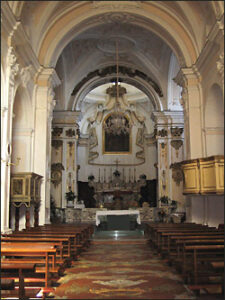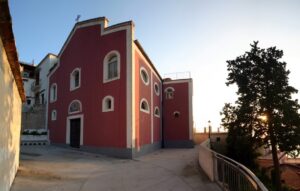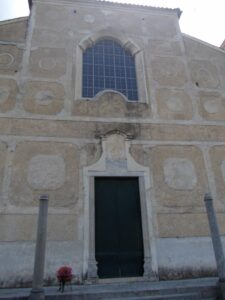There is no church on the Amalfi Coast that does not have a floor of Vietri ‘riggiole’, which are majolica tiles that came out of the ancient ‘faenzere’ developed especially in Vietri sul Mare.
The term ‘faenzera’ designated the laboratory where clay was worked, and its name derives from the city of Faenza, indicated as the place where ceramics originated. Vietri has a long and deep tradition of working with ceramic objects and tiled floors, a tradition that dates back to the 16th century with documental certainty, even though daily objects were already being produced in Vietri at the end of the 15th century.
In the 16th century ‘lancelle’ – pot-bellied containers for taking and transporting water from the springs to the houses, that could be carried by women on their heads – were mainly produced: of these objects, like bowls and jars, there was a local market that involved the entire coast and more, as will be seen in the following period. The 17th century represented a phase of strong growth for Vietri’s faenzere, especially as a consequence of the arrival of artisans from Abruzzo and Irpinia, who introduced new types of pots and new decorative motifs. At this time pottery began to be exported to Calabria and Sicily: trade was by sea, with ships bringing raw materials and foodstuffs back to the Coast. Beginning in the eighteenth century, the production of majolica tiles destined for votive shrines developed to an ever greater extent, the oldest example of which, however, dates back to 1627.
In the 19th century, the range of colors and subjects increased: manganese, copper green, yellow, and orange were added to azure and blue, and the Coast, with the picturesque contrast between the green of the mountains and the blue of the sea, was often portrayed. In the 19th century, fifteen faenzere were registered in Vietri alone, to which were added those opened by people from Vietri in other towns along the Coast, for example in Minori.
After an unstable phase that lasted until the conclusion of World War I, ceramic production was rediscovered and appreciated internationally, to the point that one can speak of a “German period.” First Dutch and then German artists came to Vietri, and by gravitating around the workshop “Manifattura Artistica Ceramica Salernitana” (Artistic Ceramics Manufactory of Salerno), they managed to mediate the local tradition with the introduction of international acquisitions that concretized the affirmation of Italian folk subjects: these ceramics were exported everywhere, from Europe to America.
It was during this period and in this cultural climate that Riccardo Dölker worked, and by decorating the ceramics produced by D’Amico, he introduced pink, light red, and – as decorative motifs – the donkey and women with the ‘lancella’ on their heads. Irina Kowaliska also worked in Vietri, reviving themes already present in the local tradition in naïf style. Among the local decorators trained under Richard Dölker was Giovannino Carrano, the highest representative of the local cultural force.
Before silk-screen printing for the decoration of riggiole (majolica tiles) was introduced in 1963, the process of creating them was long and elaborate. This is how Adriana Compagnone describes it in her study on Vietri’s ceramics:“first the riggiola was printed in the wooden template, then it was left to solidify […], then it was trimmed by placing on it an iron square of the desired size, plus a few extra centimeters for shrinkage during firing process […]. The cut was made with a crescent-shaped knife. Then the riggiola was placed on a marble surface – with the face that needed to be glazed against the marble – and was pressed with a block of heavy wood […], beating several times on the riggiola and making sure that it always fell well horizontal, preventing the riggiola from thinning on one side. Air-dried, it was put in the oven for firing and immediately afterwards was subjected to the final squaring.“. Lastly, it would be decorated – even by several people – and baked again.
Architecturally, faenzere consisted of small rooms with different functions: generally in one was the kiln, in the other the “column” in which colors were created and clay was worked. They were humid places, usually close to a spring, which took advantage of the exposed attics for the sun-drying process of the manufactured product.
The most ancient faenzere have not been preserved, while it is at least possible to identify the place where those of the nineteenth century stood. Scholar M. Antonietta Iannelli proceeded to locate the remains of nineteenth century workshops on Vietri’s territory.
1. Avallone: this pottery occupies the site of one of the oldest Vietri’s faenzera, the Cassetta faenzera of the 1500s. In the 19th century the property was divided into two workshops that belonged to Tajani and Cassetta: one consisting of three basses (*bassi) and two rooms, the other of one bass (*basso) and two rooms. However, in the land registry of 1880, appear five rooms and a mezzanine. Passing through various transfers, it became the property of Francesco Avallone in 1919.
2. Cassetta: this family also owned another faenzera. Traces of this factory, whose production was estimated at 2,000 pieces annually, were lost in the 1880s.
3. Pinto: in the land register of 1834 it appears to consist of two basses (bassi*) and colanders, although the deed of sale of the workshop to Antonio Salese (1838) mentions four basses (*bassi) with “furnace, kiln and colander.” Salese increased the size of the property with the construction of outdoor tanks for working clay, an extension from which resulted in a legal dispute with a neighbor.
4. Pizzicara/Pinto: in 1880 it was reported to consist of five basses (bassi*) and a terrane that occupied the site of an old factory run by the Sperandeo brothers. Mainly majolica tiles were produced in this faenzera.
5.5. Punzi/Cioffi: originally the building, with an entrance facing the square, was used as a residence consisting of basses (bassi*), rooms, and a garden. Only after 1837 did it become a faenzera, with an annual production of 10950 pieces. A deed of sale dated 1885 mentions eight basses (bassi*) with a furnace and kilns and a second floor with two rooms, which were enlarged after the 1919 sale to the Cioffi family.
6. Punzi/D’Agostino: from the 1880 cadastre we know that this factory stood where the “Carrera” pottery is now situated and that it consisted of seven terrane rooms. However, as early as 1832 the Punzi family owned a faenzera equipped with six factory columns, the furnace for lead, a kiln, and nine colanders. Perhaps a muffle furnace was used here for the first time.
7. Consiglio: In 1870 the production of this factory, which passed from the Consiglio family to the Martelli family, amounted to 4,000 dozen “fine faience,” 4,000 dozen “ordinary faience,” and 1,500 pieces of lead. In 1870 it consisted of eight rooms on the ground floor and seven rooms on the second floor.
8. De Simone/Tajani: originally composed of five basses (bassi*), in 1848 it produced 100000 pieces per year. In 1880 it was reported to consist of three basements, fourteen rooms on the ground floor, a mezzanine, ten rooms on the second floor, two on the second and three on the third. This is where the floor of the Church of St. Anthony in Vietri came from.
9. Genovese: consisting of six terrane rooms, this faenzera produced among other things the votive panel still present in the Autuori bakery and dated 1866.
10. Cassetta/Bottiglieri: this factory, which belonged to Baron Carmine Cassetta, consisted of three basses (bassi*) and three rooms and produced about 100000 pieces each year. In the cadastre of 1880, it appears to consist of a basement room, four rooms on the second floor, three on the second floor, and a mezzanine.
11. Cassetta/Pisapia: the productive life of this faenzera was very tormented. At the beginning of the 19th century, it consisted of four basses (bassi*) and one room and produced about 80000 pieces a year; in 1880 we find it composed of three basements, two terranes, twelve rooms on the second floor, seven on the second, one on the third, two mezzanines and three attics, although in 1896 it was divided into two workshops. Here the Solimene family began in the 1940s the successful production of ceramics.
12. Savastano/Vuolo: this workshop was short-lived. In 1887 it began the production of crockery, but already in 1899 the facilities were assigned to other activities.
13. Savastano/Della Monica: in the Petraia locality stood this factory consisting of a basement room, two on the ground floor, two on the second floor and five on the third. In the 1920s the Manifattura Artistica Ceramiche Salernitane (Artistic Ceramics Manufactory of Salerno) was set up here.
14. De Cesare/D’Amico: in the cadastre of 1834 the factory is still registered to a De Cesare, but in 1874 it was bought by Antonio D’Amico. In 1888 it employed about sixteen workers. The Aurora Hotel now occupies part of the old faenzera.
Bibl. M. A. Iannelli, Una faenzera nelle terme vietresi, Salerno, 1999.




